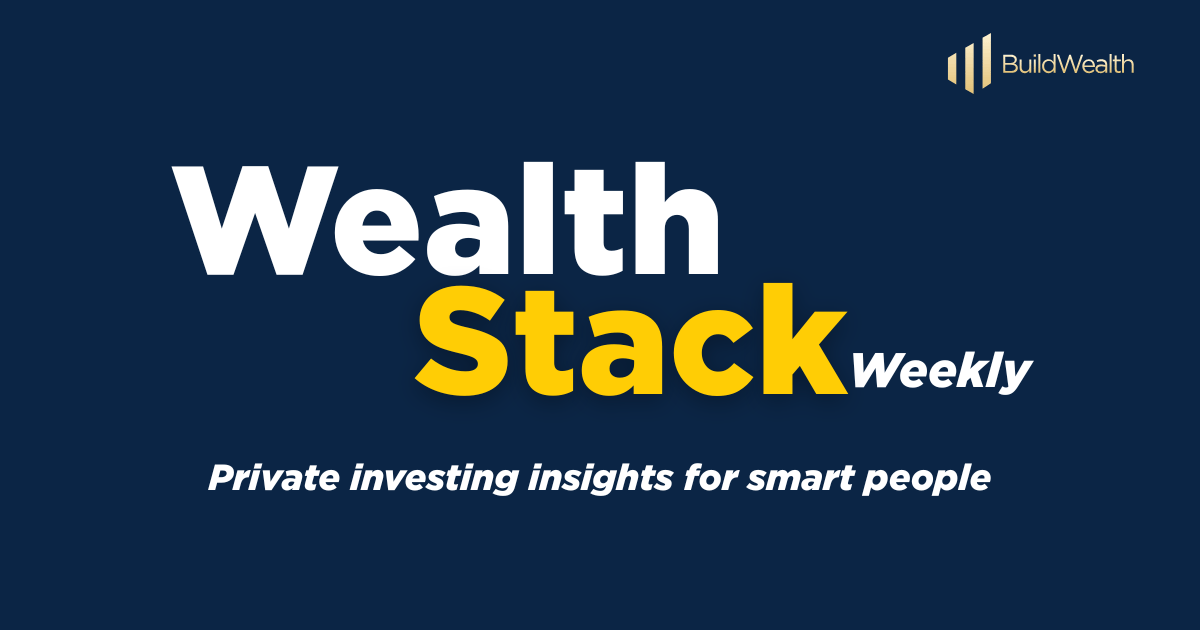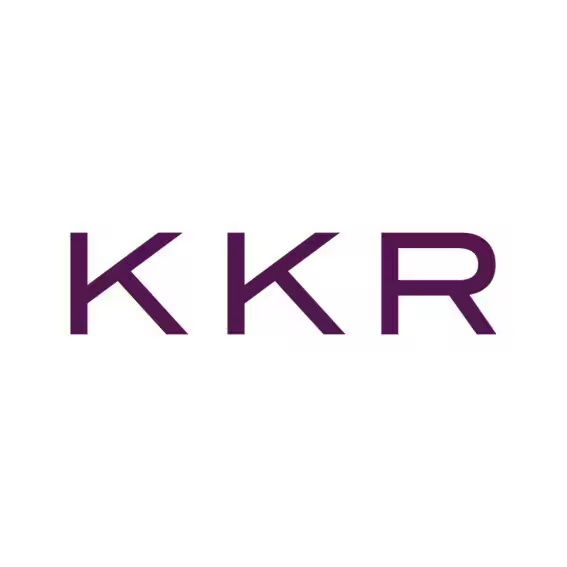- Wealth Stack Weekly
- Posts
- The 25% That Keeps Your Private Portfolio Moving
The 25% That Keeps Your Private Portfolio Moving
The best portfolios don’t abandon public markets—they repurpose them. Here’s how.

Hi ,
Wealth Stack Weekly was created for one purpose: to help accredited investors build intentional, modern, and durable portfolios, which often includes heavy expansion into private market investments, or alternatives.
Once investors get exposure to private equity, credit, and real assets, they often begin to ask “how much should I continue to hold in the public stock market?”
I get it. In the private markets:
Appreciation is higher
cash flow is stronger
volatility is lower
and the deals are fundamentally more personal
Finally, investments that work as hard as you do.
You may even wonder: do I abandon the stock market altogether?
But the best investors—the ones building multi-generational portfolios—don’t walk away from public equities. Instead, they begin to look at the stock market in a new way.

Not as a growth engine, but for liquidity, agility, and capital staging. Liquidity is the number one concern for new LPs for good reason – we all want to know our money is there if we need it (who doesn’t love a portfolio line of credit?). But if you’re like many retail investors, you may be upwards of 90% in the public markets. In other words: you’re likely more liquid than you need to be.
The real question isn’t “How much should I hold in the public market?” It's: “What role does the public market serve?”
In this week’s issue, we’re unpacking how to design your public equity sleeve like an LP, not a retail investor. We dive into:
A breakdown of the 10–25% public allocation model in Stack Shift
A case study on how Yale’s endowment leveraged public holdings
A 5-step Playbook to restructure your public sleeve
And a new Portfolio Audit Worksheet for your Toolbox to help implement the shift
If you’re serious about understanding how the stock market can actually help your private investments, this issue is for you.

SHIFT YOUR STACK
How Public Equities Serve the Wealth Stack
Most portfolios don’t fall apart because of bad picks. They underperform because they are built around volatile assets with historically modest returns.
The typical investor still holds most of their wealth in public equities because that’s what the system offers by default. Brokerage apps, financial advisors, and retirement accounts push exposure to the same basket of market-driven positions—70%+ in stocks that rise and fall in sync.
It’s convenient. But convenience isn’t a strategy.
The best allocators—those managing endowments, family offices, and post-exit capital—treat public equities with purpose. They don’t avoid them. They redefine their role within the broader stack.
Take David Swensen, who built one of the most consistently top-performing institutional portfolios ever recorded. Even while leading the charge into private markets, he maintained a 10–20% allocation to public equities for his endowment model, chosen not by default but for utility.
In the Wealth Stack framework, we observe that the best performing portfolios over time, and also current UHNWI portfolios hold a 10–25% allocation to public markets, calibrated based on the investor’s liquidity needs, time horizon, and confidence in private alternatives.
The rest of the stack lives in durable, cash-flowing and/or appreciating, and often tax-advantaged private assets: credit, real estate, operating companies, oil and gas, and niche strategies that don’t trade on headlines.
Our Wealth Stack model mirrors the portfolios of UHNWI:

Within the public slice, equities are organized by function, not by sector or style.
The 3 Roles of Public Equities in a Modern Wealth Stack
Here is our Public Role Framework. It merges endowment model thinking, family office playbooks, and modern portfolio segmentation. It aligns your public stocks with the purpose they serve.
Essentially, segment your public equities into three specific functions:
1. Smart Cash (10-20%)
Purpose: Stable, liquid, interest-earning reserves
Asset types: Short-duration dividend payers, low-volatility compounders, high-yield savings equivalents
Benchmark proxy: Ultra-short bond funds, dividend aristocrats, 1–2 year Treasuries
Capital that earns while staying accessible. Short-duration dividend payers, low-volatility compounders, and stable names that outperform cash without locking you up. This is a step beyond your “emergency cash.”
2. Optionality Plays (10-20%)
Purpose: Tactical, high-conviction, often shorter duration
Asset types: Thematic ETFs, sector tilts, global macro, special situations
Benchmark proxy: Equal-weighted sector ETFs (e.g., XLE, XLK), maybe 12–24 mo holding period
Grabbing on noticeable trends you’d like to overweight for short to mid-term plays.
3. Compounders & Growth Exposure (60-80%)
Purpose: Long-term compounding
Asset types: Broad-market index funds, innovation-driven equities, high-growth global leaders
Benchmark proxy: S&P 500, Nasdaq-100, MSCI ACWI
Long term time horizon. This is your long term, uninterrupted stock market play. Target positions for asymmetric upside. Public tech, innovation themes, and international mix.
This structure keeps allocation in public equities, but with a defined purpose. It brings clarity, control, and compounding.
They learn how to build in both markets – view the full report here.
CASE STUDY
David Swensen & The Yale Endowment
How a First-Time CIO Turned a $1B Portfolio into a $30B Powerhouse—While Holding Just 10–20% in Public Equities
“Never underestimate the gullibility of large pools of money.” - David Swenson

Image: Hearst Connecticut Media
When David Swensen took over Yale’s endowment in 1985, the portfolio looked like most others: ~70% public stocks, ~30% bonds. It was conventional. …And underperforming.
Swensen identified that liquidity was overvalued. Once a certain level of liquidity was obtained, alternative investments had an illiquidity component, but offered additional return premiums in exchange.
So… he tore up the conventional portfolio model and rebuilt it around access, alignment, and asymmetric return.
He shifted the bulk of Yale’s capital into private equity, venture, real assets, and hedge funds, cutting public equity exposure down to 15%.
Although he and his team pioneered the allocation structure to lean on the fund’s time horizon and significant investments in alts, it’s important to note that he didn’t eliminate public equities entirely. Instead, he gave them a role.
Between 1999 and 2009, Yale delivered a 13.4% annualized return. A traditional 60/40 portfolio returned a relatively anemic 2.3% over that same period.
“A combination of common sense (don’t put all your eggs in one basket) and finance theory (diversification is a free lunch) caused me to improve the diversification of Yale’s portfolio.”
— David Swensen, Forbes interview
Why He Kept Public Equities:
1. Liquidity Buffer
Public equities gave Swensen flexibility for rebalancing, covering capital calls, or deploying capital during volatility. Liquidity wasn’t the engine—it was the reserve tank.
2. Modest Long-Term Growth
Swensen didn’t chase alpha in public markets, but he recognized their role in long-term compounding—especially through global equities with lower friction and reliable exposure.
3. Strategic Diversification
Public equities moved differently than Yale’s private holdings. Emerging markets, international stocks, and select U.S. names offered non-correlation benefits without sacrificing simplicity.
“Supremely rational investors take the further step of acting against consensus, rebalancing to long-term portfolio targets by buying the out-of-favor and selling the in-vogue.”
— David Swensen, Unconventional Success
What It Means for Your Wealth Stack:
Swensen showed that disciplined allocators don’t “ride the market.” Instead, they assign purpose to every slice of capital.
Public equities weren’t his growth strategy.
They were his 1) liquidity layer, 2) diversifier, and 3) rebalancing tool.
Wouldn’t not “riding the market” be nice? ; )
IN PARTNERSHIP WITH BUILD WEALTH
Build Wealth just dropped their newest private market offering for accredited investors. BuildLegacy I aims to leverage one of the most in-demand neighborhoods in the Midwest, becoming the largest owner of real estate in the neighborhood on day one, then executing a strategic expansion strategy from there.

This isn’t a 3-5 year flip. Instead, we’re building a 10-year long opportunity to own, and build, an entire neighborhood.
This is a unique offering with the opportunity to build a diversified, 7-figure real estate portfolio with one of the heist performing real estate teams in St. Louis.
10-12% preferred return
5.3x exit multiple
BEHIND THE NUMBERS
The performance drive when private markets stack up against the traditional 60/40.

THE PLAYBOOK
How to Design a Disciplined Equity Sleeve That Serves the LP Stack
In a Wealth Stack built on private deals, public equities are no longer your foundation. They’re your liquidity and optionality layer. And they provide long term growth uncorrelated to the rest of your Stack.
If you want to think and act like an LP, here’s the playbook.
Step 1: Run a Public Role Audit
Most retail investors view their holdings by class – sector, scale, geography, but not by function. That’s where the misalignment starts.
Tag every public position using our Public Role Framework:

If a stock doesn’t serve one of these functions, it’s dead weight. Why do you own it?
Step 2: Reduce Redundancy, Increase Intentionality
The average portfolio is over-indexed to market correlation: tech-heavy, index-hugging, or duplicative funds.
Use this filter:
Given its function, is it performing?
Is this adding true function—or just familiarity?
Do I already own this exposure in another wrapper?
In a 2025 McKinsey survey, 30% of LPs increasing their private allocations started by cleaning up their public exposure to free up clarity and capital.
Step 3: Rebalance for Agility, Not Dependence
Public equities should serve your stack, not dominate it.
For an optimal portfolio, empirical evidence suggests only 10–25% of your portfolio in public equities, depending on:
Volume of total net worth (higher net worth = lower allocation to stocks)
Liquidity needs
Dry powder for opportunistic investing
Cash flow bridge between private distributions
The California Pension Fund, CalPERS—despite public equities being their highest-returning asset in FY25—is actively increasing private exposure. But only after tightening their public equity sleeve for precision.
It’s about aligning liquidity with your investments—so you’re never forced to sell the good stuff.
Step 4: Structure Liquidity by Time Horizon
Not all liquidity is equal. Your public equity layer should be structured by function and by your time frame.

Step 5: Upgrade Your Metrics
If you want to behave like an allocator, you need to track more than just asset class exposure.
Here’s what to track in your public sleeve:
% of public holdings by role (Compounder / Income / etc.)
Liquidity-weighted return expectations
Capital availability by time horizon
Correlation overlap with private market theses
This is how family offices and institutional LPs manage liquidity risk without holding excessive idle cash. Their public sleeve is their shock absorber, not their growth engine.
So, What To Do Now
Tag every holding using the defined framework
Trim what doesn’t serve a clear purpose
Rebalance to a 10–25% range that supports your private stack
Track liquidity by horizon—not just by label
This is how real LPs use public equities.
Every dollar has a job: earn, protect, or flex.
Build your public sleeve with the same intentionality you bring to private deals—and it becomes a weapon, not a weight.
WEALTH STACK TOOLBOX
The Public Equity Role Audit Worksheet
→ Get the Tool
Most investors hold public stocks by default—not design. This worksheet helps you fix that.
It’s a simple, visual tool to map, tag, and restructure your public sleeve based on function: Compounders. Optionality. Smart Cash.
Why it matters?
Your liquid layer should support your private stack—not dilute it.
Use it to:
Audit what’s productive vs. what’s just familiar
Identify gaps, idle capital, and time horizon misfits
Rebuild with clarity and intention
Make your public sleeve earn its place in the portfolio.
MINDSET SHIFT
Public Equities Aren’t Your Foundation
Too many investors treat public equities like a strategy. They’re just the part of your stack that’s liquid-on-demand.
In a modern portfolio, public positions exist to give you liquidity, flexibility, and timing. That’s it.
When every dollar is working as hard as you do, the slice of public stocks stops being noisy. It stops being emotional. It stops reacting. It has a job, and therefore starts performing.
Serious allocators assign capital by purpose. Don’t ride the market, use it.
So ask yourself:
What are your public holdings actually doing for you?
Clarity will come from the answer.
WHAT WE ARE READING
"If you want something you have never had, you must be willing to do something you have never done."
Thomas Jefferson





